With a vast and rich experience in providing Raman solutions to customers in various industries, we are proud to launch our Handheld Raman Analyser - LABORAM series. We have successfully launched the systems as 2 variants LABORAM 785 and LABORAM 1064. LABORAM 785 is compact, lightweight and easy-to-operate and uses the 785nm wavelength for analysis. And the LABORAM 1064 excels at fluorescence resistance in order to suit the detection of high fluorescence materials in a non destructive manner.

Laboram785 is a handheld Raman analyser which is compact, lightweight and easy-to-operate. It employs an Android platform and has a easy to use, user interface. It comes with 5.5’ high definition screen, a dual camera of 13-mega plus 8-mega pixel taking evidence pictures in the field.
Read More Request Quote

With its compact size and extremely light weight (1150kg) it can be widely used in industries relating to public safety, laboratories, plant, warehouse etc Utilizing Raman technology, analysis can be performed through transparent containers, all while maintaining the volume and integrity of the sample.
Read More Request Quote
FAQ's
It's a spectroscopy technique which can determine vibrational modes of a molecule and provides structural fingerprint of the molecule to identify. One can think of a complementary technique against FTIR but with more advantages like non-destructive, non-contact way of analyzing sample.
Raman spectrometer integrated to an optical microscope is called a Raman microscope where the user can focus the point of probing using the microscope objectives and the white light guides the exact location of probing and taking a picture and subsequently Raman spectroscopy of the same location provides chemical finger printing of the exact location. This Raman microscopy is more useful for R&D and research Laboratory environment. But it’s not necessary to have an optical microscope to be connected to the Raman spectrometer. There are more applications especially in industry where a Raman spectrometer is used without a microscope.
Raman is useful to identify a chemical compound within a few seconds with great confidence even without touching it, without destroying it.
Handheld Raman systems are for field application purposes. One of the example area is for Pharma & Bio Pharma manufacturing. To follow cGMP guidelines, manufacturers need to inspect every in-coming Raw Materials for each containers or packs and Handheld Raman provides huge ROI for manufacturers for this material testing purposes.
Yes this is absolutely possible.
Definitely Yes. United States Pharmacopeia Chapter 1120 is dedicated to Raman Spectroscopy and Chapter 197 (Spectroscopic Identification Tests) provides methodology for chemical identification of materials, such as active pharmaceutical ingredients (API), excipients or drug compounds in various stages of the manufacturing process.
Based on the above methodology and using the FDA regulatory guidance for 21CFR part 11 for Electronic Signature and Records, manufactures are using Different Raman systems in various stages of Pharma/ Bio Pharma Manufacturing to get maximum ROI.
Raman results are just like a normal graph where in X axis is generally the wavenumbers are plotted and on Y axis the intensity level.
Raman results are Qualitative and with advancement of chemometrics methods one can also use it as a Quantitative way. That means one can identify an unknown compound comparing sample’s Raman data against a Raman Library database or can verify a compound with certainty against a particular method. Further, with the help of a chemometric methods one can identify the concentrations or other parameters of compounds or a mixture of compounds. In general, quantitative Raman methods to establish is very expensive and mostly useful in the production environment.
We have gone through all possible solutions in the present market and devised our solution in such a way which is more technically advanced but less in weight and high in performance. Our design makes system weight only 450 gm and has a big 5.5 inch display with a spectral resolution 8-10 cm-1 and range of 200-4000 cm-1 which are the highest in Industry. Also we have made a special arrangement for battery and one can use the system continuously for 24 X 7 without even changing the battery.
Yes, Our Handheld Raman systems comes with Cameras in-built to take pictures of the samples while getting their signature spectrum. Pictures are also included in the records.
Yes, All of our systems follow the regulatory guidelines of 21 CFR Part 11 for all electronic data and record.
Yes, systems are capable to be used with LIMS.
Yes, Our Handheld Raman systems comes with an inbuilt Barcode scanner to ease the process of creating sample information for records.
785nm Laser is a NIR Diode Laser and most efficiently used for Raman analysis as it covers almost every types of sample be it Pharma, Bio Pharma, Explosives, Narcotics or any other polymer or chemicals etc. Using 785 nm laser makes systems much smaller, energy efficient and rugged and easy to use.
1064 nm Laser is an IR Diode laser and also being used in Raman spectroscopy. It can also cover most of the samples for Raman analysis. Even few samples which have fluorescence in other wavelengths can be identified suing 1064nm laser but it makes systems heavier and bigger in size.
For FDA purpose, there is no in-built Library required and the manufacturers have to create their own methods to work with their samples.
Yes, all of our systems allow users to create their own library and the in-built algorithm can verify a known sample or identify unknown samples against that library.
Raman spectrometers can be divided mostly in a 4 different types based on it Applications area.
a. The smallest is the Handheld type Raman spectrometer which are weighing mostly in grams like 500-600 gms. Mostly useful for field applications like Geology, Mineral and Mining etc and most importantly incoming Raw materials identification for Pharma Manufacturing. These systems are capable to very specific job of verifying or identifying compounds of interest, operates with a battery with inbuilt Library and compound analysis algorithm.
b. The next is a Portable type, a bit high resolution than handheld and value for money in QC/QA environment where a particular SOP in place. They are basically placed between Handheld systems and high end Research Grade systems in terms of price and technical capabilities.
c. Then comes the Research Grade systems, where resolution, sensitivity, range etc are at the highest possible category commercially available and equipped with highest possible customizations for probing samples in different ways or environments. These kinds of systems are mostly in Research Laboratories and more useful for R&D. For more information: https://labindiainstruments.com/renishaw-raman-microscope.html
d. Another kind of Raman system are there which is mostly called PAT (process Analytical Tool). They are the backbone for the manufacturing plants especially in Pharma, Bio Pharma, Perto Chemicals etc. to monitor reactions or a process in real time and giving feedback to control the reaction in real time to get maximum output.
Yes. Not only an Optical Microscope but one can even attach an AFM (Atomic Force Microscope) or an SEM (Scanning Electron Microscope) with Raman spectrometer. For more information: https://labindiainstruments.com/nanonics-imaging-limited.html
Yes, online Raman systems or like PAT (Process Analytical Tool) are very much popular now in Pharma, Bio Pharma Petroleum and Chemical Industries. ROI (Return on Investment) of these process Raman tool is tremendous.
Benchtop Raman are generally for QC/QA labs or for Graduate Students or for Preliminary research training purposes in Academic or Research environment.
They are mostly useful for real time process analytical purposes and controlling a reaction or process efficiently in manufacturing environment like – Pharma, Bio Pharma, Chemical or Petroleum etc.
This is one of the reason Raman outperforms FTIR in real world environment outside laboratory environment. In Raman spectroscopy, water is a good medium and it has negligible effect on sample data and one can easily identify compounds even in water solution.
Raman as a basic tool works as a Qualitative way and at the same time semi-Quantitative way. Thanks to the advancement of Chemo-metrics Methodologies, now Raman data is being used as agnostic way of determining any unknown data with very high Quantitative accuracy which can actually compete with traditional Quantitative Methods like HPLC.
In a Pharma / Bio Pharma manufacturing environment, most of the containers are actually Raman transparent and one does not need to take out their samples to test. Raman systems can check samples inside plastic or brown paper containers easily unless there is some special types of container material. There is a big list of container materials through which Raman can work without taking samples outside. Please contact us for more information.
Yes, Raman can be used for any kind of surfaces or even any kind of samples be it liquid, gas or solid.
Yes, Raman can be helpful to identify chemical compounds to do reverse engineering.
Yes, Raman data can be used for patent infringement and an integral part of Patent Protection for drug discovery/ development purpose.
